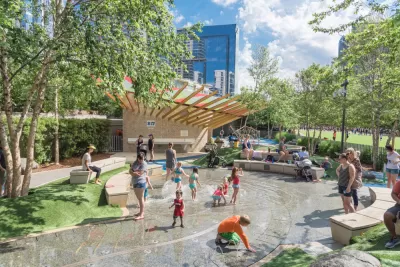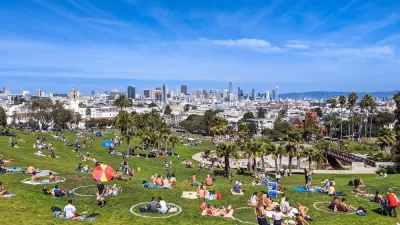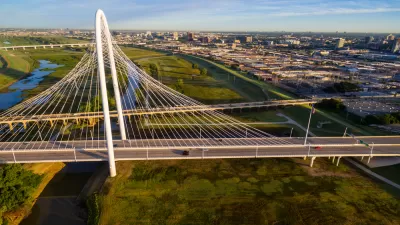The new urban public realm in the United States is highly programmed—some of that design approach reflects the trends of culture and some reflects a history of violence and bad for PR for parks at the end of the 20th century.

John King writes on the current trends in park design…actually, park programming. King's treatise begins with the example of Klyde Warren Park in Dallas.
Klyde Warren Park, constructed over a recessed stretch of the Woodall Rodgers Freeway, is a source of civic pride, a weekend magnet for residents from throughout the region, and a marketing hook used to lure residents to the glass condominium towers nearby. But in a broader sense, it is emblematic of the kind of public space favored by American cities at the moment—meticulously designed and programmed, city owned but privately funded and maintained, with an ever-changing array of carefully curated experiences. At Klyde Warren, you can play pétanque or croquet, laser tag or chess. You can practice your putting or take a ballroom dance class. No need to bring your own Jenga blocks; they can be checked out from the well-stocked Reading and Games Room. Public spaces such as this—picturesque destinations with plenty to offer and little left to chance—are made for the Instagram age. If they enrich public life in an era when the competition for resources is intense, they’re also oddly suited to an American culture in which the unknown is increasingly feared, and being aimless is the biggest sin of all.
Other, relatively recently designed and opened parks are compared for similarities—Millennium Park in Chicago, the High Line in New York City, Public Square in Cleveland, Crescent Park in New Orleans, Salesforce Park in San Francisco, Campus Martius Park in Detroit, Franklin Square in Philadelphia, and LeBauer Park in Greensboro, North Carolina.
Perhaps the most famous park of U.S. history offers a contrast. Frederick Law Olmsted and Calvert Vaux chose a decidedly different approach when designing Central Park in New York City, explains King:
When the pair designed New York’s Central Park, Olmsted sought to “completely shut out the city from our landscapes,” crafting refuges where people “may stroll for an hour, seeing, hearing, and feeling nothing of the bustle and jar of the streets, where they shall, in effect, find the city put far away from them.”
This long-read digs much deeper into the concepts and parks that best exemplify the tension between programmed park space and a more open approach. Regarding the latter approach, King identifies a term from sociology called "Loose Space" and also finds contemporary landscape architects who prefer a less programmed nature in parks.
King also helpfully notes that while the debate surrounding the tension between programming and nature gets attention in academia and from erudite designers, politicians are neglecting to pay much attention to these distinctions.
FULL STORY: At Play in the Fields of the Bored

Study: Maui’s Plan to Convert Vacation Rentals to Long-Term Housing Could Cause Nearly $1 Billion Economic Loss
The plan would reduce visitor accommodation by 25,% resulting in 1,900 jobs lost.

North Texas Transit Leaders Tout Benefits of TOD for Growing Region
At a summit focused on transit-oriented development, policymakers discussed how North Texas’ expanded light rail system can serve as a tool for economic growth.

Using Old Oil and Gas Wells for Green Energy Storage
Penn State researchers have found that repurposing abandoned oil and gas wells for geothermal-assisted compressed-air energy storage can boost efficiency, reduce environmental risks, and support clean energy and job transitions.

Santa Barbara Could Build Housing on County Land
County supervisors moved forward a proposal to build workforce housing on two county-owned parcels.

San Mateo Formally Opposes Freeway Project
The city council will send a letter to Caltrans urging the agency to reconsider a plan to expand the 101 through the city of San Mateo.

A Bronx Community Fights to Have its Voice Heard
After organizing and giving input for decades, the community around the Kingsbridge Armory might actually see it redeveloped — and they want to continue to have a say in how it goes.
Urban Design for Planners 1: Software Tools
This six-course series explores essential urban design concepts using open source software and equips planners with the tools they need to participate fully in the urban design process.
Planning for Universal Design
Learn the tools for implementing Universal Design in planning regulations.
Ascent Environmental
Borough of Carlisle
Institute for Housing and Urban Development Studies (IHS)
City of Grandview
Harvard GSD Executive Education
Toledo-Lucas County Plan Commissions
Salt Lake City
NYU Wagner Graduate School of Public Service





























